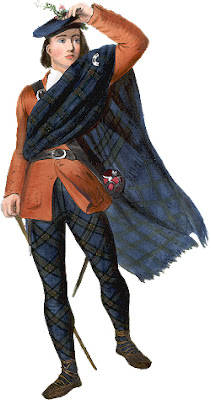Medieval clothing and fashion like everything else was dictated by the
Pyramid of Power which was the Feudal System. Medieval clothes provided
information about the status of the person wearing them. This was not just
dictated by the wealth of the person. Only Royalty were permitted to wear
clothes trimmed with ermine. Lesser Nobles were allowed to wear clothing trimmed
with fox and otter. There were other
Medieval clothing rules! The wives and
children of tradesmen were to wear:
"No veils, but such as are made with thread, nor any kinds of fur except
those of lambs, rabbits, cats and fox"
A 14th Century Act of Parliament decreed that:
"All labourers and lower classes of people shall wear no kind of cloth but
blankets and russets, nor use any girdles than such of those made of linen"
Medieval Clothing - The Fabrics
The type of cloth and fabric used for Medieval clothing was therefore
extremely important. People of the Lower Classes wore clothing generally made of
wool, linen and sheepskin. Medieval Nobles and Upper classes wore clothing made
of velvets, furs, silks, lace, cottons and taffeta. Knights returning from the
Crusades returned with silks and cottons from the Middle East. Velvets were
imported from Italy. The materials worn by the Nobility came in a variety of
different colors. The dyes used for coloring these clothes were expensive. The
red dye came from a Mediterranean insect which provided a bright scarlet color.
Green dyes came from lychen. the Dyerswoad plant provided dyes for the remaining
blue-based colors.
Practical Medieval Clothing
The early Medieval clothing was distinguished by lots of different layers
of clothing. Much of the time was spent outdoors or in draughty, cold castles
and it was necessary to invest in warm clothing layers.
The Medieval Clothing of Peasants
The Medieval clothing of peasant men consisted of a Knee length tunic
fastened with a belt. Others wore linen shirts or rough woollen shirts. Peasant
men often went bare-legged or simply bound their legs with strips of linen.
Peasant women wore a longer dress made of similar material which was also
fastened with a belt.
Medieval Clothing of Noblemen
The Medieval clothing of the Noblemen consisted of trousers covered with
long over tunics called bliauds. Tabards and Surcoats were also worn. These
clothes were covered with full length cloaks. The cloaks were trimmed with an
expensive fur and pinned at the shoulder with a broach. They wore shoes designed
for castle wear made of silk, velvet, cloth or leather and fastened with a
buckle. The indoor shoes worn with Medieval clothing were covered with wooden
and leather outdoor overshoes. Hats were also part of a nobles clothing which
were similar to a cap and pointed at the front. The materials were made of
velvets, silks, lace, cottons and taffeta and dyed in bright colors. In the 14th
century Medieval clothing included underclothes consisting of breeches, chemise
and hose. Additional information is available by clicking the following link
-Medieval Knights Armor
Medieval Clothing of Noble Women
The Medieval clothing of the Noble women consisted of many layers of
clothes. They wore underclothes consisting of breeches, chemise and hose. The
underclothes in Medieval Clothing were covered with an underskirt usually made
of yellow or white linen or silk. The underskirt was covered with a long,
trailing gown, or dress, with wide sleeves. The gowns were made of velvets,
furs, silks, lace, cottons and taffeta. The hem and the neck of the gown (dress)
and sleeves were often decorated with gems and lace. The gowns were covered with
long over tunics called bliauds. Tabards and Surcoats were also worn over the
gowns and dresses. These clothes were covered with full length mantel. The
mantels were trimmed with an expensive fur and pinned at the shoulder with a
broach. They wore shoes designed for castle wear made of silk, velvet, cloth or
leather and fastened with a buckle. The indoor shoes were covered with wooden
and leather outdoor overshoes. Women wore their hair long and plaited which was
covered by a Wimple or a Guimpe - a piece of silk or linen draped and pinned
over the hair, wrapped around the throat and tucked into the neckline of the
gown. Hats were were later added as part of the clothing of a noble women which
grew bigger as fashion dictated featuring tall points, some shaped as the horns
of cows. The Medieval Clothing materials were made of velvets, silks, lace,
cottons and taffeta and dyed in bright colors.
Peasant men often wore woolen jackets with woolen pants or knickers. This
ensemble was sometimes accented with a cottonshirt. Peasant men also wore
medium-length tunics with bare legs or stockings. The tunics would be cinched
with a rope or sash. Shoes and hats were luxuries that not all could afford, but
peasant men sometimes wore shoes and hats made of cloth. What is commonly known
as the wench look was the norm for female peasants.
The wench look consisted of a long tunic commonly referred to as a kirtle.
Kirtles were made of various materials, but usually of wool or linen for
peasants. Kirtles were either laced in front similar to acorset or they were
laced down the back. A loose fitting shirt would normally be worn underneath the
kirtle if it were short-sleeved. A shirt may or may not have been necessary if
the kirtle was long-sleeved. Long-sleeved kirtles usually had bell sleeves,
which made an undershirt unnecessary.
Unlike the rich, peasants could not afford the services of tailors,
seamstresses, or weavers. Peasants were known to make their own clothes. Money
was hard to come by so peasants often resorted to alternate means of meeting
their needs. The barter system was popular. Bartering enabled peasants to trade
goods or food in exchange for clothes and shoes. If a peasant could make good
quality clothes, shoes, or hats, then they were in high demand and had an easy
time trading in exchange for necessities.




